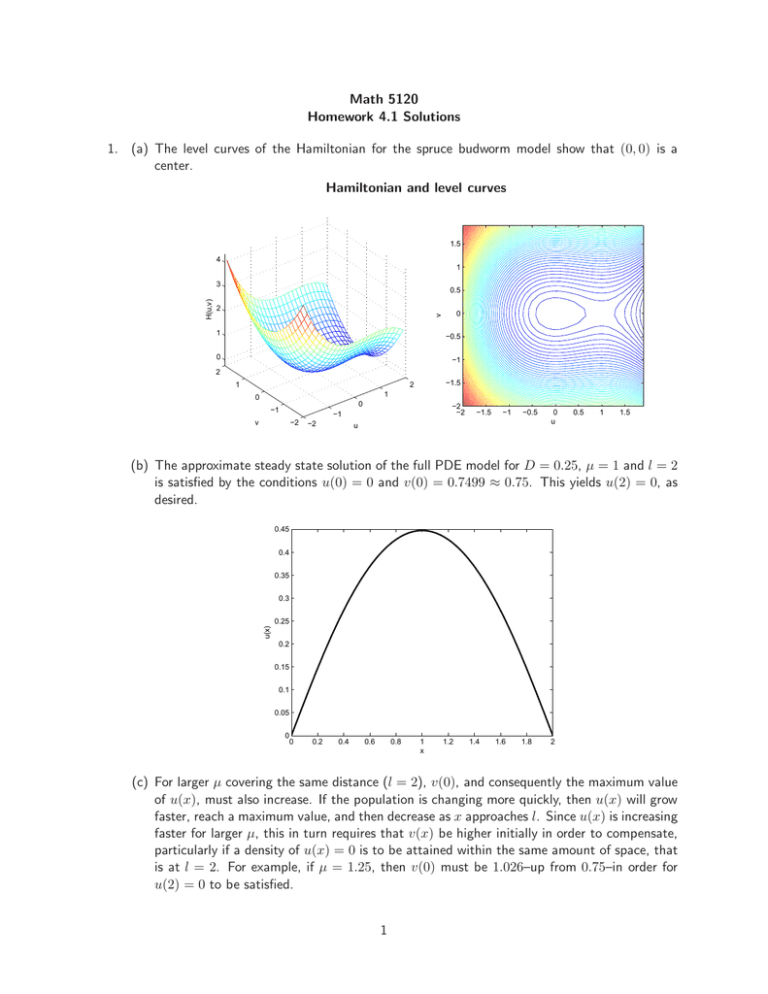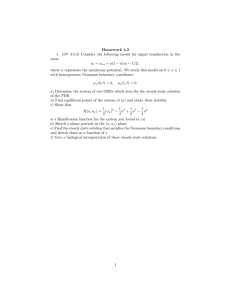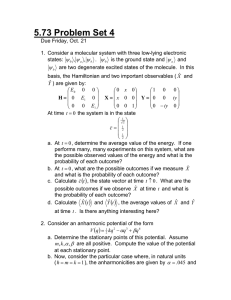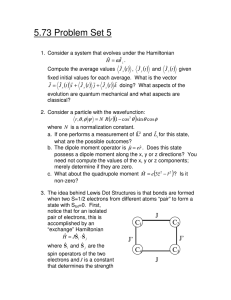Math 5120 Homework 4.1 Solutions
advertisement

Math 5120 Homework 4.1 Solutions 1. (a) The level curves of the Hamiltonian for the spruce budworm model show that (0, 0) is a center. Hamiltonian and level curves 1.5 4 1 0.5 2 0 v H(u,v) 3 1 −0.5 0 −1 2 1 −1.5 2 1 0 0 −1 −2 −2 −1 v −2 −2 −1.5 −1 −0.5 u 0 u 0.5 1 1.5 (b) The approximate steady state solution of the full PDE model for D = 0.25, µ = 1 and l = 2 is satisfied by the conditions u(0) = 0 and v(0) = 0.7499 ≈ 0.75. This yields u(2) = 0, as desired. 0.45 0.4 0.35 0.3 u(x) 0.25 0.2 0.15 0.1 0.05 0 0 0.2 0.4 0.6 0.8 1 x 1.2 1.4 1.6 1.8 2 (c) For larger µ covering the same distance (l = 2), v(0), and consequently the maximum value of u(x), must also increase. If the population is changing more quickly, then u(x) will grow faster, reach a maximum value, and then decrease as x approaches l. Since u(x) is increasing faster for larger µ, this in turn requires that v(x) be higher initially in order to compensate, particularly if a density of u(x) = 0 is to be attained within the same amount of space, that is at l = 2. For example, if µ = 1.25, then v(0) must be 1.026–up from 0.75–in order for u(2) = 0 to be satisfied. 1 Homework 4.2 Solutions 1. (a) The system of ODEs that describes the steady-state solution of ut = uxx + u(1− u)(u− 1/2) is u′ = v v ′ = −u(1 − u)(u − 1/2), where u′ and v ′ are derivatives with respect to x. The corresponding boundary conditions are v(0) = v(l) = 0. (b) The Jacobian of the linearized system is 0 J(u, v) = 3u2 − 3u + 1 2 1 0 The equilibria of this system and corresponding stability are as follows: q • P1 = (0, 0): The eigenvalues of J(0, 0) are λ1,2 = ± 12 , and so this point is a saddle. • P2 = ( 12 , 0): The eigenvalues of J( 12 , 0) are λ1,2 = ± 21 i, and so this point is a possible center. (This can be verified by looking at the level curves of the Hamiltonian found in part (c)). q • P3 = (1, 0): The eigenvalues of J(1, 0) are λ1,2 = ± 12 , and so this point is also a saddle. ∂H ′ ′ (c) Recall that a Hamiltonian is some function H(u, v) satisfying ∇H = ∂H , ∂u ∂v = (−v , u ). To determine H(u, v), we integrate. 3 1 ∂H = −v ′ = −u3 + u2 − u ∂u 2 2 1 1 1 ⇒ H(u, v) = − u4 + u3 − u2 + c1 (v) 4 2 4 1 ∂H ′ = u = v ⇒ H(u, v) = v 2 + c2 (u) ∂v 2 1 2 1 4 1 3 1 2 ⇒ H(u, v) = v − u + u − u 2 4 2 4 0.5 0.4 0.3 0.2 v 0.1 0 −0.1 −0.2 −0.3 −0.4 −0.5 −0.5 0 0.5 u 2 1 1.5 (d) The (u, v) = (u, ux ) plane has the phase portrait shown below. 0.8 0.6 0.4 v 0.2 0 −0.2 −0.4 −0.6 −0.8 −0.5 0 0.5 u 1 1.5 (u0, v0) = (0.45, 0) (u0, v0) = (0.55, 0) 0≤ x≤ 2π 0≤ x≤ 2π 0.54 0.54 0.52 0.52 u(x) u(x) (e) The possible steady-state solutions satisfying the homogeneous Neumann boundary conditions for 0 ≤ x ≤ l = 2π are shown as functions of x below. 0.5 0.5 0.48 0.48 0.46 0.46 0.02 −0.005 0.015 −0.01 v(x) v(x) 0 0.01 0.005 0 −0.015 −0.02 0 2 4 6 x 0 2 4 6 x (f) These steady-state solutions reflect the membrane potential along the length of the axon. 3











